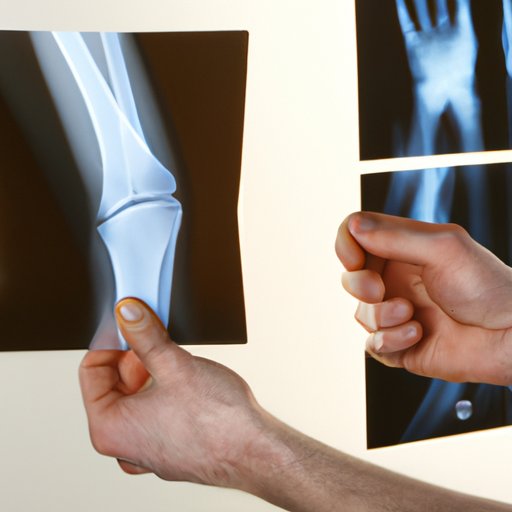
Introduction
Diagnosing arthritis early on is crucial to managing the condition and improving quality of life. Unfortunately, many people are unaware of the signs and symptoms of arthritis, and may not seek help until the condition has significantly worsened. In this article, we will provide a comprehensive guide to diagnosing arthritis, from identifying symptoms to seeking medical care.
7 Common Symptoms of Arthritis to Look Out For
The most common symptoms of arthritis include joint pain, stiffness, and swelling. These symptoms may be accompanied by a reduced range of motion, fatigue, and fever. If you experience any of these symptoms on a regular basis, it’s important to consult a doctor. Some specific examples of symptoms to look out for include:
- Morning stiffness in the joints
- Pain or tenderness in the joints when touching or moving
- Swelling in one or more joints
- A grinding sensation, or the feeling of bones rubbing together
- A reduced range of motion
- Warmth or redness around the joint area
- Difficulty performing daily activities, such as gripping objects or walking
Diagnosing Arthritis: What Exams and Tests to Expect
When you consult a doctor for suspected arthritis, they will likely begin with a physical exam and review of your medical history. Your doctor may ask you about your symptoms, any past injuries or surgeries, and your family medical history. After the exam, your doctor may order several different tests to determine the cause of your symptoms. Some of the most common tests used to diagnose arthritis include:
- X-rays
- Magnetic resonance imaging (MRI)
- Ultrasound
- Blood tests
- Joint fluid analysis
From X-Rays to Blood Tests: A Comprehensive Guide to Diagnosing Arthritis
If you need to undergo diagnostic tests for arthritis, it’s important to understand what each test entails and what kind of information it can provide. For example, X-rays can help identify bone damage or deformity, while MRI and ultrasound can help identify damage to soft tissues like ligaments, tendons, and cartilage. Blood tests can also provide valuable information about the immune system and inflammation levels in the body. There are several different types of blood tests you may undergo, including:
- Rheumatoid factor (RF) test
- C-reactive protein (CRP) test
- Erythrocyte sedimentation rate (ESR) test
- Antinuclear antibody (ANA) test
The Importance of Early Detection: How Arthritis Diagnosis Can Improve Quality of Life
Early diagnosis is crucial to successfully managing arthritis. When arthritis goes undiagnosed, it can lead to a decline in quality of life, as well as possible joint damage or deformation. On the other hand, when arthritis is diagnosed early, there are many opportunities for treatment and symptom management. Early treatment can also help prevent further joint damage or deformities from occurring.
Misconceptions About Arthritis Diagnosis: Debunking Myths and Understanding the Truth
There are many misconceptions surrounding arthritis and its diagnosis. Some people believe that only elderly people get arthritis, while others think that arthritis is simply a normal part of getting older. In reality, anyone can develop arthritis, regardless of age. Additionally, while arthritis is more common among older adults, it can also develop in children, teenagers, and young adults. Another common misconception is that there is no cure for arthritis – while there may not be a cure, there are many treatment options available that can help manage symptoms and improve quality of life.
Diagnosing Arthritis: When to Consult a Doctor and What to Ask
If you suspect you may have arthritis, it’s important to consult a doctor as soon as possible. Your doctor can help you determine whether or not you have arthritis, and recommend appropriate treatment options if necessary. When consulting with a doctor, be prepared to ask the following questions:
- What type of arthritis do I have?
- What are my treatment options?
- What kind of lifestyle changes should I make?
- What kind of medications should I take?
- What kind of exercises should I do?
- How often should I come back for follow-up appointments?
A Step-by-Step Guide to Self-Diagnosing Arthritis: How to Monitor Your Symptoms and Seek Treatment
If you suspect you may have arthritis, there are several steps you can take to self-diagnose and seek treatment. One way to monitor your symptoms is to keep a journal of when and where you experience pain or stiffness. You can also try to identify any triggers that exacerbate your symptoms, such as certain foods or activities. Another crucial step is to schedule an appointment with a doctor as soon as possible. Your doctor can help determine the cause of your symptoms and recommend appropriate treatment options.
Conclusion
Diagnosing arthritis early on is crucial to managing the condition and improving quality of life. By staying informed about the signs and symptoms of arthritis, seeking medical attention when necessary, and working with a doctor to develop a treatment plan, patients can effectively manage their symptoms and lead healthy and active lives.




